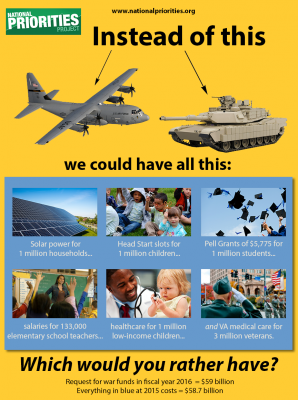
By Lindsay Koshgarian
The economy has had its chance, and failed: it just doesn’t provide for all of us. Whether you’re feeling trapped by student debt or working part-time instead of full-time because that’s all you could find, the free market isn’t coming to your rescue.
The fact is, an economy that works for everyone will be an economy where the federal government plays a bigger role. That’s right, I said it: the answer is big government.
The federal government is the single entity best positioned to steer us toward a more equal future, with serious investment in job creation, infrastructure, education, transportation, and innovations to combat climate change, among other things. Now, cue up the naysayers: how will we pay for our big government?
If you said taxes, you’d be right, but only partly: of course we need to insist that corporations and the wealthiest Americans pay their fair share of taxes. Americans support a more fair tax system, and the kind of investment we need depends on it.
It’s hard to overstate how lopsided our tax system is. Since the 1940s, the share of taxes paid by corporations has drastically declined, from nearly 40 percent to 11 percent in 2015. Individual taxpayers pick up the slack.
Meanwhile tax breaks for both corporations and individuals have skyrocketed: worth only $285 billion in today’s dollars forty years ago, they’re worth over $1 trillion today. And of the biggest tax breaks, nearly one in five dollars benefits the wealthiest one percent.
There are some common sense fixes: raising the top income tax rates for individuals with the highest incomes, closing tax loopholes like the capital gains special rate, and closing corporate loopholes like those that allow U.S. corporations to hold profits offshore. We should overhaul our tax policy to do these, and more.
But there’s another, less recognized way we could fund the investment we need. If there’s one area where even our anti-tax politicians have gone happily about creating big government without batting an eye, it’s the Pentagon.
How big of a problem is this? Well, in 2015 the Pentagon had at its disposal a $64 billion slush fund that was roughly equal to all federal student aid that year. And that was just the slush fund: total Pentagon and related spending came in at more than $600 billion, more than half of the federal discretionary budget.
Pentagon defenders use any number of arguments to defend this status quo. They funnel hundreds of billions of dollars to contractors like Lockheed Martin and call it job creation. But this is old economy thinking. The fact is that the same dollars could create more jobs in health care or education. They claim we need this investment for national security. But it’s easy to see now that U.S. attempts to address threats primarily through military action often backfire, making us less safe, as they have with the creation of ISIS in Iraq.
Cutting the Pentagon budget by just one percent – easy to do without risking national security, by cutting down on pet weapons systems, reducing the bureaucracy that anti-government ideologues love to hate, or limiting deals with service contractors – could free up the cash to:
- Add more than half a million Head Start slots, increasing program participation by more than 50%; or
- Send 600,000 students to college, tuition-free; or
- Power more than 5 million households with renewable wind;
Every single year.
A new economy that offers something for everyone will take government investment, big time. And to make that happen, we need to take on not only our broken tax system, but the too-big Pentagon.
 Lindsay Koshgarian is research director of the National Priorities Project.
Lindsay Koshgarian is research director of the National Priorities Project.
Follow us: Twitter YouTube Facebook